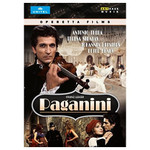|
Back
04/19/2017
Franz Lehár: Paganini
Antonio Theba (Niccolò Paganini), Teresa Stratas (Princess Anna Elisa), Johannes Heesters (Prince Felice), Dagmar Koller (Bella Giretti), Peter Kraus (Giacomo Pimpinelli), Fritz Tillmann (Count Carcasona), Wolfgang Luckschy (Count Hédouville), Klaus Havenstein (Bartucci), Symphony Orchestra Kurt Graunke, Munich, Wolfgang Ebert (Musical Director), Eugen York (TV Director), Rolf and Alexandra Becker, Eugen York (TV Adaptation), Bert Grund (Musical Arrangement), Peter Zeumer (Production Manager), Günter Haase, Jürgen Jürges (Camera), Peter Kramper, Hartmut Tscharke, Gerhard Müller (Sound), Gisela Haller (Editing), Gerd Staub (Set Designer), Irms Pauli (Costume Designer), Freddy Arnold, Karin Bauer (Make-up Designers), Heinz Schmiedel, Maria Litto (Choreographers)
A production of Unitel in cooperation with ZDF/ORF © Unitel 1973 – 107’
Arthaus Musik Cat #: NTSC 109309 – Sound PCM Stereo – Format 4:3 – Region 0 – Booklet in English – Subtitles in German, English and French

   
This fictionalized snippet taken from life of famed Niccolò Paganini has all the excesses of a Hollywood-hyped musical. Paganini melodies don’t seem to “grab”, in contrast to those which can be found inside Lehár’s more memorable operettas…that isn’t to say the harmonies aren’t lush and magical. Similar to Arthaus Musik’s Der Opernball, Eugen York assumes the television direction even though the product is a bit off the mark, not because of singing, per se, but due to a strikingly unpolished product seen through the eyes of Gisela Haller’s unsophisticated, roughened film edit: here we find a series of scenes unremarkably strung together without any creative energies behind it.
Irms Pauli costuming is certainly opulent (not only for village folk numbers, but for Napoleon’s aristocratic Lucca principality.) The aforementioned dressing helps heft the predominant Paganini/Princess Anna Elisa love affair via Antonio Theba’s and Teresa Stratas’ romantic chemistry…palpable enough for the silver screen, but not indelibly ingrained.
Although famed Austrian tenor, Richard Tauber, was slated for the title role at the Viennese premiere in 1925, he couldn’t obligate himself due to a prior concert booking. Nonetheless, he went on to successfully appear in Berlin’s 1926 engagement despite his “unpersuasive” looks in capturing the essence of Paganini, the composer. Lehár tailored his music to fit M. Tauber’s voice, yet Mr. Theba adds his own cinematic dimensions that get to the core of Paganini: deeply rugged looks, devilishly virtuosic talents on the violin (wonderful), intoxicating personality and an acting acumen which make him out to be a persuasive womanizer. This works exceedingly well in this Arthaus Musik DVD. Antonio Theba’s tenor register has supple flexibility to attain Lehár’s occasionally high reaches though these notes tend to come in with half the voice. Teresa Stratas is a dream soprano with brassy edging and bona fide acting skills.
Sexual proclivities run rampant in Paganini which sends a compelling argument of Niccolò Paganini’s overtly forward advances...but he’s not the only one. The notion of Paganini’s continuous engagements with the opposite sex and an addiction to gambling allows the plot to grow and grab for a moment or two. Austrian darling Dagmar Koller is the flittering coquette, Bella Giretti who balances several gents on her arms, one being the lascivious Prince Felice (Johannes Heesters) while Peter Kraus’ prissy Pimpinelli radiates a grossly appropriate amount of arrogance, egoism and condescension...he’s the comic relief nudging inside the score.
Gerd Staub’s settings traverse between studio and live outdoor shots (filmed on location in Austria); the latter is particularly breathtaking. These alternations, though pleasing enough, get side swiped by sudden camera cuts which abrasively sever whatever flow already exists. Choreography by Heinz Schmeidel and Maria Litto show the casts’ sharpness in movements in group numbers (predominately presented inside the studio which features an energetic tarantella and a suave ballet divertissement ahead of Paganini’s court concert.) Color abounds yet there is a heavy dose of kitsch that comes with this Paganini.
If Lehár’s music grabs you, you’ll likely be drawn to take a look at this rather historic 1973 production. Editing shortfalls make Paganini less credible.
Christie Grimstad
|